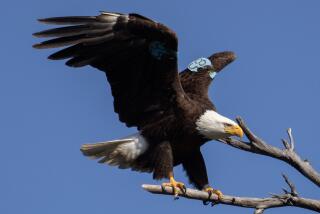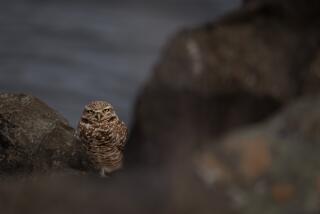Eagle views Santa Barbara Zoo as a cafeteria
Reporting from Santa Barbara -- It started with the toucans.
Nobody knew why the birds were making such a terrible racket but soon it became clear.
A bald eagle had winged its way into the Santa Barbara Zoo and started evidencing great interest in some of the zoo’s smaller, perhaps more delectable, inhabitants. He swooped low over the flamingos and perched on a rooftop just above the achingly cute meerkats, waiting. He showed no fear of humans.
“At first we were thrilled to see it,” said Sheri Horiszny, the zoo’s director of animal programs. “But then we had to be a lot less excited when it seemed he might be here for the long haul.”
For two weeks earlier this month, the zoo was gripped in what might be described as a mild form of eagle mania. Federally protected, the eagle couldn’t be trapped — or even bothered — without a permit. Meanwhile, he was eyeballing captive wildlife and devouring cormorants — seabirds that flock to the zoo from the nearby shoreline — at the rate of at least one every other day.
“It would have been a big hit to our collection if he’d eaten one of our animals every other day,” Horiszny said.
The bald eagle might be a symbol of America’s freedoms but that doesn’t include a free lunch.
Keepers moved 16 macaws, 13 otters, four chuckwallas, four rabbits, two meerkats, two cranes, two ground hornbills and a black-necked swan out of their open-air enclosures and into eagle-proof shelter. A party equipment firm donated the use of a 30-foot by 30-foot tent to protect the rare Asian small-clawed otters. At one point, someone thought of floating a large balloon up to one of the eagle’s favorite perches, signaling that it was time for him to move on. It had no effect.
He perched atop the California condors enclosure — the five huge birds gazed up at him, curious — and visited the bald eagles, who were quite vocal about their uncaged relative. Whether he was drawn by the birds or by their food no one knows. But his interest in other species was clear as he flapped around the zoo, checking them out.
Nesting, the flamingos couldn’t be moved. From dawn to dusk — the hours that eagles tend to seek food — a zoo employee armed with a garden hose was posted beside the graceful birds, ready to spray if need be.
Officials were initially told that acquiring an eagle-relocation permit would take six months. But they kept pressing: All they had to do was recall the time in 2009, when a larger bald eagle that was hanging out in nearby Santa Barbara Cemetery flew across the road and indulged in a buffet of cormorants, picking them out of the eucalyptus trees near the elephants.
After she was full, she flew away, perhaps back to her home on Santa Cruz Island.
U.S. Fish and Wildlife Service officials — along with those of several other involved agencies — expedited the permit and on Sept. 11, wildlife biologist Peter Sharpe set out to trap the eagle. A dead rabbit and a “power snare” didn’t do the trick. But when the bird flew into a boulder crevice near the gorilla habitat, Sharpe followed.
“You get a sheet over them so they can’t see what’s going on, and then you get control of their feet,” said Sharpe, who wore thick leather welder’s gloves for the task.
Sharpe, an Institute for Wildlife Studies expert who runs eagle restoration programs on the Channel Islands, said the bird was immature “and not the best of hunters”. A bald eagle from the wild was drawn to condors at the Los Angeles Zoo a few years ago but did not linger long, he said.
Santa Barbara’s visiting eagle was driven to a raptor center in Davis, Calif., and then released in eagle territory near Lake Shasta.
“We certainly wish him nothing but well,” Horiszny said. “We’re hoping he’ll hook up with some other eagles and find out what eagles are supposed to do.”
More to Read
Start your day right
Sign up for Essential California for news, features and recommendations from the L.A. Times and beyond in your inbox six days a week.
You may occasionally receive promotional content from the Los Angeles Times.







